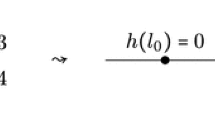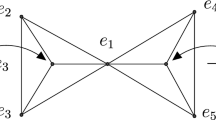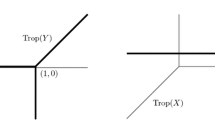Abstract
We give several characterizations of stable intersections of tropical cycles and establish their fundamental properties. We prove that the stable intersection of two tropical varieties is the tropicalization of the intersection of the classical varieties after a generic rescaling. A proof of Bernstein’s theorem follows from this. We prove that the tropical intersection ring of tropical cycle fans is isomorphic to McMullen’s polytope algebra. It follows that every tropical cycle fan is a linear combination of pure powers of tropical hypersurfaces, which are always realizable. We prove that every stable intersection of constant coefficient tropical varieties defined by prime ideals is connected through codimension one. We also give an example of a realizable tropical variety that is connected through codimension one but whose stable intersection with a hyperplane is not.
Similar content being viewed by others
References
Allermann, L., Rau, J.: First steps in tropical intersection theory. Math. Z. 264(3), 633–670 (2010)
Babaee, F., Huh, J.: A tropical approach to the strongly positive Hodge conjecture. arXiv:1502.00299
Bogart, T., Jensen, A.N., Speyer, D., Sturmfels, B., Thomas, R.R.: Computing tropical varieties. J. Symb. Comput. 42(1–2), 54–73 (2007)
Cartwright, D., Payne, S.: Connectivity of tropicalizations. Math. Res. Lett. 19(5), 1089–1095 (2012)
Fulton, W., Sturmfels, B.: Intersection theory on toric varieties. Topology 36(2), 335–353 (1997)
Hampe, S.: a-tint: a polymake extension for algorithmic tropical intersection theory. Eur. J. Combin. 36, 579–607 (2014)
Jensen, A.N.: Gfan, a software system for Gröbner fans and tropical varieties. http://home.imf.au.dk/jensen/software/gfan/gfan.html
Jensen, A., Yu, J.: Computing tropical resultants. J. Algebra 387, 287–319 (2013)
Katz, E.: Tropical intersection theory from toric varieties. Collect. Math. 63(1), 29–44 (2012)
Kazarnovskiĭ, B.Y.: c-fans and Newton polyhedra of algebraic varieties. Izv. Ross. Akad. Nauk Ser. Mat. 67(3), 23–44 (2003)
McMullen, P.: The polytope algebra. Adv. Math. 78(1), 76–130 (1989)
McMullen, P.: On simple polytopes. Invent. Math. 113(2), 419–444 (1993)
Mikhalkin, G.: Tropical geometry and its applications. In: Proceedings of the International Congress of Mathematicians, vol. II, pp. 827–852 (Madrid, 2006, Zürich, Switzerland). European Mathematical Society (2006)
Maclagan, D., Sturmfels, B.: Introduction to Tropical Geometry, Graduate Studies in Mathematics, vol. 161. American Mathematical Society, Providence (2015)
Osserman, B., Payne, S.: Lifting tropical intersections. Doc. Math. 18, 121–175 (2013)
Rau, J.: Intersections on tropical moduli spaces. arXiv:0812.3678
Richter-Gebert, J., Sturmfels, B., Theobald, T.: First steps in tropical geometry. In: Idempotent Mathematics and Mathematical Physics, Contemporary Mathematics, vol. 377, pp. 289–317. American Mathematical Society, Providence (2005)
Sturmfels, B., Tevelev, J.: Elimination theory for tropical varieties. Math. Res. Lett. 15(3), 543–562 (2008)
Sturmfels, B.: Solving systems of polynomial equations. In: CBMS Regional Conference Series in Mathematics, vol. 97. Published for the Conference Board of the Mathematical Sciences, Washington (2002)
Tverberg, H.: How to cut a convex polytope into simplices. Geom. Dedicata 3, 239–240 (1974)
Yu, J.: Algebraic matroids and realizability of tropical varieties up to scaling. arXiv:1506.01427
Ziegler, G.M.: Lectures on Polytopes, Graduate Texts in Mathematics, vol. 152. Springer, New York (1995)
Acknowledgments
We thank Diane Maclagan for reading and providing feedback on an earlier draft and the referees for many helpful suggestions that greatly improved the exposition. The first author was supported by the Danish Council for Independent Research, Natural Sciences (FNU), and the second author was supported by the NSF Grant DMS #1101289.
Author information
Authors and Affiliations
Corresponding author
Appendix: Proofs of some results in Sect. 2
Appendix: Proofs of some results in Sect. 2
Here, we present detailed, careful proofs of some results needed to derive the dimension formula, balancing condition, and associativity of stable intersection. Although elementary, these proofs, especially that of Lemma 2.11, are some of the most difficult in this paper. Many subtle and intricate details need to be worked out.
We start by recalling the setting and some definitions from Sect. 2. Let X be a tropical cycle in \(N_{\mathbb {R}}\) and \(A: N \rightarrow N'\) be a linear map between lattices, inducing a linear map \(A : N_{\mathbb {R}}\rightarrow N'_{\mathbb {R}}\). We can endow A(X) with a polyhedral structure such that the image of each face of X is a union of faces of A(X). For any point \(\omega \in A(X)\) lying in the relative interior of a facet, let
where the sum runs over one v for each facet of X meeting the preimage of \(\omega \).
Lemma 2.2. Let \(\tau \) be a ridge in X such that \(A(\tau )\) also has codimension 1 in \(A ({{\mathrm{link}}}_X(\tau ))\). Then \(A ({{\mathrm{link}}}_X(\tau ))\) is balanced with multiplicity defined in (1).
Proof
Let \(\tau \) be a ridge in X such that \(A(\tau )\) also has codimension 1 in \(A({{\mathrm{link}}}_X(\tau ))\). From the balancing condition on X at \(\tau \), we have
Applying the map A gives
Observe that \([ N'_{A \sigma } : N'_{A \tau } +{{\mathrm{span}}}_{\mathbb {Z}}(A v_{\sigma /\tau })] v_{A\sigma /A\tau } \equiv A v_{\sigma /\tau }\) (mod \({{\mathrm{span}}}_{\mathbb {Q}}(AN_\tau )\)) and
Hence,
This proves that the image of a neighborhood of \(\tau \) is balanced with the multiplicities given by formula (1). \(\square \)
Lemma 2.10. Let X be a tropical cycle and H be a tropical cycle whose support is an affine hyperplane, both with positive multiplicities. Then \(X \cdot H\) is also a tropical cycle, possibly zero, with \({{\mathrm{codim}}}(X\cdot H)={{\mathrm{codim}}}(X)+1\).
Proof
From Lemma 2.6, we get \(\dim (X\cdot H)\le \dim (X)-1\).
If X is contained in a finite union of hyperplanes parallel to H, then it is clear from the definition that \(X \cdot H\) is empty (hence a zero cycle).
Suppose X is not contained in finitely many hyperplanes parallel to H. We wish to prove that every point \(\omega \) in \(X \cdot H\) is contained in a face of dimension \(\dim (X)-1\) in \(X \cdot H\). By taking links if necessary, by Lemma 2.8, we may assume that \(\omega = 0\) and that X is a fan and H is a hyperplane through the origin. Also assume that H has multiplicity 1.
Choose a maximal cone of X which is not contained in H and let S be its affine span. Let U be a complementary subspace of \(S \cap H\) in H, so \(U \subset H\), \(\dim (U) = {{\mathrm{codim}}}(X)\), and \(S+U=N_{\mathbb {R}}\).
Since the multiplicities are positive and \(X +U\) contains a full-dimensional cone, we have \(X +U = N_{\mathbb {R}}\) with positive multiplicities. Consider cones of the form \(\sigma +U\) where \(\sigma \) is a maximal cone of X and \(\sigma +U\) is full dimensional. These cones must cover all of \(N_{\mathbb {R}}\), and they also cover all of H in particular. Hence, there is a maximal cone \(\sigma \) of X such that \(\dim (\sigma + U)=n\) and \(\dim ((\sigma + U)\cap H)=n-1\). Since \(\dim (\sigma +U) = n\), we also have \(\dim (\sigma + H) = n\), so \(\sigma \cap H \subset X \cdot H\) by definition. Since \(\sigma + U\) is full dimensional inside H, and \(\dim (U) = n - \dim (X) = n-1 - (\dim (X) - 1),\) we must have \(\dim (\sigma \cap H) \ge \dim ((\sigma +U)\cap H)-\dim (U)=n-1-\dim (U)=\dim (X)-1\) as desired. This completes the proof that \(X \cdot H\) has expected codimension.
We will now check that \(X \cdot H\) is balanced. By taking links at a ridge of \(X \cdot H\) and quotienting out by the lineality space parallel to the ridge, we can assume that X is a two-dimensional fan. For a generic vector v, \(H + v\) intersects X transversely, and \(X \cdot H\) consists of unbounded rays of \(X \cap (H + v)\) counted with multiplicity. To show the balancing of the rays of \(X \cdot H\), following the ideas leading to Eq. (4), it suffices to show balancing at every vertex of \(X \cap (H + v)\).
By taking links at vertices of \(X \cap (H+v)\), we only have to consider the case when X is a two-dimensional fan with one-dimensional lineality space \(\tau \) and H does not contain \(\tau \). In this case, for any facet \(\sigma \) in X, \(\sigma \cap H\) is a ray in \(X \cdot H\). Let \(v_\sigma \) be the primitive lattice vector in the ray \(\sigma \cap H\). Then, by the definition of multiplicities in stable intersections, we have
On the other hand, since X is balanced, we have
Moreover, we have \(v_\sigma - [N_\sigma : {{\mathrm{span}}}_{\mathbb {Z}}(v_\sigma ) + N_\tau ] \cdot v_{\sigma /\tau } \in {{\mathrm{span}}}_{\mathbb {Q}}(N_\tau )\). Combining the last two statements and multiplying through with \([N : N_H + N_\tau ]\) gives
This shows that \(X \cdot H\) is balanced. \(\square \)
Lemma 2.11. Let X be an arbitrary tropical cycle with positive multiplicities. Suppose Y is a tropical cycle of codimension r whose support is an affine linear space such that \(Y = ((H_1 \cdot H_2) \cdots H_r)\) where \(H_1,\dots ,H_r\) are tropical cycles with positive multiplicities whose supports are affine hyperplanes. Then
In particular, it follows that \(X\cdot Y\) is a tropical cycle since the right-hand side is a tropical cycle by Lemma 2.10.
Proof
We will use induction on r. When \(r=1\), the statement is trivial. Suppose \(r \ge 2\), and by the inductive hypothesis, we have
where \(L = ((H_1\cdot H_2)\cdots H_{r-1})\). Hence, \(Y = L \cdot H_r\). It remains to prove that
We know that \((X\cdot H_r) \cdot L\) is a tropical cycle because it is equal to \((((X \cdot H_r)\cdot H_{r-1})\cdots H_1)\), which is a tropical cycle by the previous lemma. At this point, we have not shown yet that \( X \cdot (H_r \cdot L)\) is a tropical cycle.
For simplicity of notation, let \(H = H_r\). By taking links, for equality of the supports in (8) it suffices to prove that \((X \cdot H) \cdot L\) is non-empty if and only if \(X \cdot (H \cdot L)\) is non-empty. For any linear space V, \(X \cdot V\) is non-empty if and only if the projection of X onto a complement \(V^\perp \) of V is surjective. Let \(\pi _H\), \(\pi _L\), and \(\pi _{HL}\) be projections from \(N_{\mathbb {R}}\) onto the \(H^\perp \), \(L^\perp \), and \((H \cap L)^\perp \), respectively. Since \(H + L = N_{\mathbb {R}}\), we have \(H^\perp \cap L^\perp = \{0\}\), so \((H \cap L)^\perp \) is a direct sum of \(H^\perp \) and \(L^\perp \), and \(\pi _H + \pi _L = \pi _{HL}\).
Suppose \((X \cdot H) \cdot L\) is non-empty. Then, there is a cone \(\sigma \in X\) such that
Thus, \(X \cdot (H \cdot L)\) is non-empty.
Now, suppose \(X \cdot (H \cdot L)\) is non-empty. Then, \(\pi _{HL}(X) = H^\perp + L^\perp \), so there exists a \(\sigma \in X\) such that
Then, \(\dim (\pi _H(\sigma ))=\dim (H^\perp )\), so \(\sigma \cap H\) is a cone in \(X \cdot H\). We will show that \(\sigma \cap H \cap L\) is a cone in \((X \cdot H)\cdot L \) by showing that \(\pi _L(\sigma \cap H) \supset \pi _{HL}(\sigma )\cap L^\perp \), which is full dimensional in \(L^\perp \).
Let \(v \in \pi _{HL}(\sigma )\cap L^\perp \). Let \(v' \in \sigma \) such that \(\pi _{HL}(v')=v\). Then,
but \(\pi _H(v')\) is also in \(H^\perp \), so \(\pi _H(v') = 0\). Hence, \(v' \in H\), and
This proves that \(\dim (\pi _L(\sigma \cap H))\ge \dim (\pi _{HL}(\sigma )\cap L^\perp )=\dim (L^\perp )\). Therefore, \((\sigma \cap H)\cap L\) is a face of \((X\cdot H)\cdot L\), proving that \((X\cdot H)\cdot L\) is non-empty.
We have proven that the supports of \((X\cdot H) \cdot L\) and \(X \cdot (H \cdot L)\) coincide. Since \((X\cdot H) \cdot L\) is pure of expected dimension, \(X \cdot (H \cdot L)\) is as well.
To compute multiplicities, for simplicity suppose H and L have multiplicity 1 everywhere. After taking links and taking quotients, we may assume that the support of the stable intersections on both sides of (8) consists only of the origin. For generic \(v_2\in N_{\mathbb {R}}\), we have by Definition 2.4
where, for generic \(v_1\in N_{\mathbb {R}}\),
Since \({\text {mult}}_{H\cdot L}({H\cap L})=[N:N_{H}+N_{L}]\), we have
for generic \(v_3\in N_{\mathbb {R}}\).
For X, H and L fixed, let v and \(v_2\) be generic vectors in \(N_{\mathbb {R}}\). Since X is a finite polyhedral complex, for all sufficiently small \(\varepsilon > 0\), the set of facets \(\sigma \in X\) such that \(\sigma \cap (H+\varepsilon v) \cap (L+v_2) \ne \emptyset \) is constant. Let \(v_1 = \varepsilon v\) where \(\varepsilon >0\) is sufficiently small and \(v_3=v_1+v_2\). We will show that the collections of \(\sigma \)’s appearing in both of the multiplicity formulas above are the same (where each \(\tau \) has the form \(\sigma \cap H\)). For this, we need
Since \(H+L = N_{\mathbb {R}}\), we may assume without loss of generality that \(v_1 \in L\) and \(v_2 \in H\). Then, we have \((H \cap L) + v_1 + v_2 = (H+v_1) \cap (L + v_2)\). Now suppose that \(\sigma \cap ((H\cap L)+v_1+v_2)\not =\emptyset \). Then, \(\sigma \cap (H+v_1) \cap (L + v_2) \ne \emptyset \). This is true for all sufficient small \(v_1\)’s and \(\sigma \) is closed, so we get \(\sigma \cap (H+v_1)\not =\emptyset \) and \(\sigma \cap H \cap (L+v_2)\not =\emptyset \).
Conversely, because \(\sigma \cap H \cap (L+v_2)\not =\emptyset \) and \(v_2\) is generic, \(\text {dim}(\sigma \cap H)\) is at least the codimension of \(H \cap (L+v_2)\) in H, so
We assumed that \(X \cdot (H \cdot L)\) is 0-dimensional, and we have shown above that the stable intersection of a tropical cycle and a linear space has the expected dimension, so \(\text {dim}(\sigma )=\text {codim}(H\cap L)\). Then,
Moreover, \(\sigma \) is not contained in H, so \(\dim (\sigma )=\dim (\sigma \cap H)+1\). Combined with \(\sigma \cap (H+v_1)\not =\emptyset \) and genericity of \(v_2\), this shows that offsetting \((H\cap L)+v_2\) a small amount in direction v will keep the intersection \(\sigma \cap ((H\cap L)+v_2+\varepsilon v)\) non-empty. This completes the proof that the \(\sigma \)’s appearing in the sums are the same.
Since \(N_{\tau }=N_{H}\cap N_{\sigma }\), to prove that the two multiplicities are equal, it suffices to prove for subgroups A, B, C of an abelian group N with well-defined indices:
and apply this equation to \(A=N_H,B=N_L,C=N_\sigma \). All subgroups of which we take indices contain \(A\cap B\). After quotienting out by \(A\cap B\), we may assume that we are in the case where \(A\cap B=\{0\}\). Then,
The first and fourth equalities use the facts that \(A \cap B = \{0\}\). For the third equality, notice that \(a+C = b+C\) if and only if \(a + A\cap C = b+ A \cap C\) for all \(a,b \in A\). The rest follow from standard isomorphism theorems. \(\square \)
Lemma 2.12. Let \(X, L_1,\) and \(L_2\) be tropical cycles with positive multiplicities, and suppose that the supports of \(L_1\) and \(L_2\) are affine linear spaces. Then
Proof
For each linear space L with multiplicity 1 and codimension r, we can find hyperplanes \(H_1,\dots ,H_r\) with multiplicities 1 so that \(L = ((H_{\sigma (1)} \cdot H_{\sigma (2)})\cdots H_{\sigma (r)})\) for every permutation \(\sigma \) of \(\{1,\dots ,r\}\). To see this, choose a lattice basis B of \(L \cap N\) and extend this to a lattice basis \(B' = B \cup \{v_1,\dots ,v_r\}\) of N. For \(i = 1,\dots ,r\), let \(H_i\) be the hyperplane in \(N_{\mathbb {R}}\) spanned by \(B' \backslash \{v_i\}\). Then, it is straightforward to see by induction on i that the tropical cycle \(((H_{\sigma (1)} \cdot H_{\sigma (2)})\cdots H_{\sigma (i)})\) has support \(H_{\sigma (1)}\cap \cdots \cap H_{\sigma (i)}\) with multiplicity 1 for each \(i=1,\dots ,r\).
Without loss of generality, we may assume that both \(L_1\) and \(L_2\) have multiplicity 1 everywhere. As shown above, we can find hyperplanes \(H_1,\dots ,H_r\) and \(H_1',\dots , H_s'\) so that \(L_1 = ((H_{\sigma (1)} \cdot H_{\sigma (2)})\cdots H_{\sigma (r)})\) for every permutation \(\sigma \) of \(\{1,\dots ,r\}\) and \(L_2 = ((H_1' \cdot H_2')\cdots H_s')\). By Lemma 2.11 above, we have
\(\square \)
Rights and permissions
About this article
Cite this article
Jensen, A., Yu, J. Stable intersections of tropical varieties. J Algebr Comb 43, 101–128 (2016). https://doi.org/10.1007/s10801-015-0627-9
Received:
Accepted:
Published:
Issue Date:
DOI: https://doi.org/10.1007/s10801-015-0627-9




